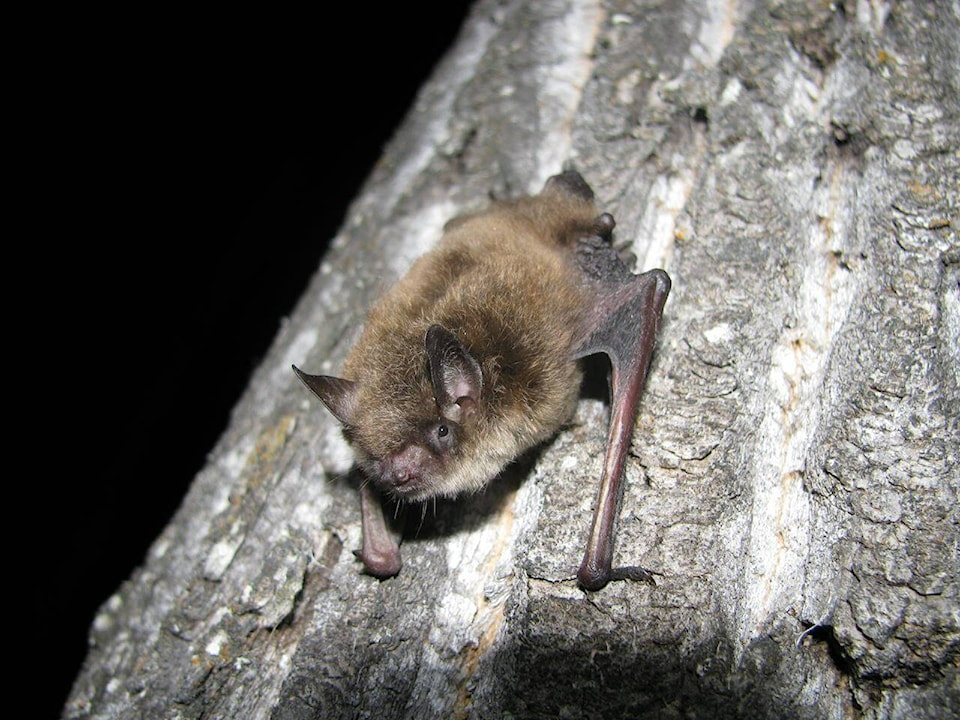Red Deer’s bat population could be imperiled by the fatal fungus that causes white-nose syndrome.
And if the bat population dips, mosquitoes and other pests tend to flourish.
Red Deer Polytechnic biology instructor Sally Stuart, who has been recording audio of bats near the Red Deer River with her students since 2019, fears fewer high-frequency sounds will be picked up this spring.
Since the fungus that causes white-nose syndrome was detected in the province last year, Stuart is concerned it could now be spreading and killing Alberta bats.
The Pseudogymnoascus destructans fungus usually affects bats during hibernation. Powdery growth on their skin causes the bats to wake prematurely, dehydrate and starve.
White-nose syndrome is particularly fatal to little brown bats — the kind most commonly found in the Red Deer area, said Stuart.
She expects to find out in June whether the local bat population has taken a hit.
Four years ago, the RDP faculty members first set up bat recording equipment in a forested area north of 67th Street. The monitoring that usually starts in May is being done close to where the North Highway Connector will be built across the Red Deer River.
There’s now a more pressing reason to track the bat population — other than researching road construction impacts — since the fatal syndrome fungus is present, said Stuart.
While bats are known to be occasional carriers of rabies and other diseases, the flying mammals are highly important to the ecosystem. They eat a variety of flies, mosquitoes and other invertebrates that can plague humans and also pass diseases to people and agricultural crops, said Stuart.
As high-frequency bat sounds usually can’t be picked up by the human ear, a specialized audio recorder afixed to a fence is used for the monitoring project. Stuart said the sounds are then put through a computer program that attempts to pinpoint what kind of bat species they belong to. But it is not an exact science, she added.
Unlike birds, bats do not have their own ‘bat song’ but instead throw out high-frequency sounds as a way of locating food sources. If these sounds bounce off flying insects, then bats can locate their prey. Stuart said many of the sounds are similar, so can be hard for the computer to differentiate.
In past years, the RDP student research project has uncovered a lot of nocturnal bat activity in the area. While the computer has identified mostly little brown bats, and other bats in the Myotis family, some larger silver-haired bats and hoary bats were also detected, said Stuart, who noted big brown bats are not too common in this area.
Scientists know little about bat habits, particularly where they hibernate. While a few species are known to migrate south, others, including little brown bats, are thought to overwinter in caves near the Rocky Mountains, said Stuart.
The damp and cold cave climate is thought to be particularly conducive to the spread of the fungus that causes white-nose disease. As a result, the little brown bat was recently listed as federally endangered in Canada, due to the devastating impact of white-nose syndrome across North America.
The bat monitoring project is just one of several student-faculty projects at RDP.
Among the other projects, Cyrus Taheri, science and technology instructor, is leading a student research into the studying the types of fungi that establish either helpful or harmful relationships with white spruce and trembling aspen trees.
And mechanical engineering instructor Craig West, did a student exploration of micro-energy storage systems that can capture and release excess electrical energy produced by solar or wind power.
lmichelin@reddeeradvocate.com
Like us on Facebook and follow us on Twitter
